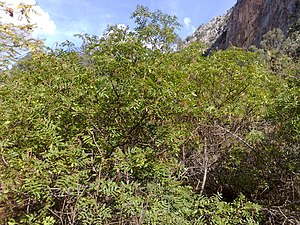Note: This is a project under development. The articles on this wiki are just being initiated and broadly incomplete. You can Help creating new pages.
Rhus coriaria
Rhus coriaria is a deciduous shrub that can grow up to 3 metres tall. The plant is harvested from the wild for local use as a food, medicine and source of materials. It is sometimes grown as an ornamental in garden. The plant is classified as 'Vulnerable' in the IUCN Red List of Threatened Species(2013).
Contents
- 1 Uses
- 2 Parts Used
- 3 Chemical Composition
- 4 Common names
- 5 Properties
- 6 Habit
- 7 Identification
- 8 List of Ayurvedic medicine in which the herb is used
- 9 Where to get the saplings
- 10 Mode of Propagation
- 11 How to plant/cultivate
- 12 Commonly seen growing in areas
- 13 Photo Gallery
- 14 References
- 15 External Links
Uses
Dysentery, Haemoptysis, Conjunctivitis, Diarrhoea.[1]
Parts Used
Chemical Composition
In total 191 compounds were identified in sumac fruit including, 78 hydrolysable tannins (Gallic acid), 59 flavonoid such as, Apigenin, 40 other compounds such as Butein, 9 anthocyanins such as Cyanidin.[2]
Common names
| Language | Common name |
|---|---|
| Kannada | |
| Hindi | |
| Malayalam | |
| Tamil | |
| Telugu | |
| Marathi | |
| Gujarathi | |
| Punjabi | |
| Kashmiri | |
| Sanskrit | |
| English |
Properties
Reference: Dravya - Substance, Rasa - Taste, Guna - Qualities, Veerya - Potency, Vipaka - Post-digesion effect, Karma - Pharmacological activity, Prabhava - Therepeutics.
Dravya
Rasa
Guna
Veerya
Vipaka
Karma
Prabhava
Habit
Identification
Leaf
| Kind | Shape | Feature |
|---|---|---|
Flower
| Type | Size | Color and composition | Stamen | More information |
|---|---|---|---|---|
| {{{5}}} |
Fruit
| Type | Size | Mass | Appearance | Seeds | More information |
|---|---|---|---|---|---|
Other features
List of Ayurvedic medicine in which the herb is used
Where to get the saplings
Mode of Propagation
Seeds, Cuttings of half-ripe wood, Root cuttings, Suckers.
How to plant/cultivate
Rhus coriaria is not very cold-hardy, tolerating short-lived temperatures down to around -5°c when it is fully dormant, and is unlikely to succeed outdoors in any but the mildest parts of the temperate zone.[4]
Commonly seen growing in areas
Rocky places, Waysides, On limestone.
Photo Gallery
- Თუთუბო Rhus coriaria Gerbersumach, Gewürzsumach (2).JPG
- Თუთუბო Rhus coriaria Gerbersumach, Gewürzsumach.JPG
References
- ↑ Indian Medicinal Plants by C.P.Khare
- ↑ Chemical constituents
- ↑ [Morphology]
- ↑ Cultivation
External Links
- Pages with broken file links
- Ayurvedic Herbs known to be helpful to treat Dysentery
- Ayurvedic Herbs known to be helpful to treat Haemoptysis
- Ayurvedic Herbs known to be helpful to treat Conjunctivitis
- Ayurvedic Herbs known to be helpful to treat Diarrhoea
- Herbs with Immature fruits used in medicine
- Herbs with Leaves used in medicine
- Habit - Deciduous shrub
- Index of Plants which can be propagated by Seeds
- Index of Plants which can be propagated by Cuttings of half-ripe wood
- Index of Plants which can be propagated by Root cuttings
- Index of Plants which can be propagated by Suckers
- Herbs that are commonly seen in the region of Rocky places
- Herbs that are commonly seen in the region of Waysides
- Herbs that are commonly seen in the region of On limestone
- Herbs



